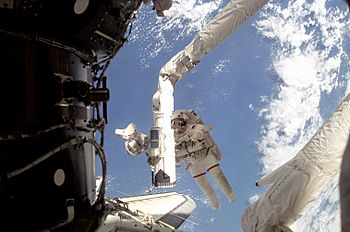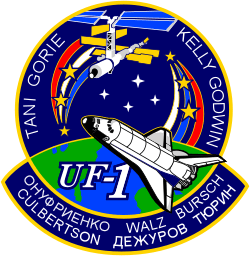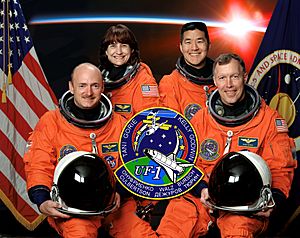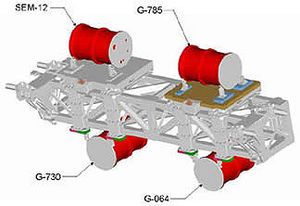STS-108 facts for kids

Godwin on Endeavour's Canadarm during an EVA
|
|
| Mission type | ISS crew rotation |
|---|---|
| Operator | NASA |
| Mission duration | 11 days, 19 hours, 36 minutes, 45 seconds |
| Distance travelled | 7,700,000 kilometres (4,800,000 mi) |
| Spacecraft properties | |
| Spacecraft | Space Shuttle Endeavour |
| Payload mass | 4,082 kilograms (8,999 lb) |
| Crew | |
| Crew size | 7 |
| Members |
|
| Launching |
|
| Landing |
|
| EVAs | 1 |
| EVA duration | 4 hours, 12 minutes |
| Start of mission | |
| Launch date | 5 December 2001 22:19:28 UTC |
| Launch site | Kennedy LC-39B |
| End of mission | |
| Landing date | 17 December 2001 17:56:13 UTC |
| Landing site | Kennedy SLF Runway 15 |
| Orbital parameters | |
| Reference system | Geocentric |
| Regime | Low Earth |
| Perigee | 353 kilometres (219 mi) |
| Apogee | 377 kilometres (234 mi) |
| Inclination | 51.6 degrees |
| Period | 92 minutes |
| Docking with ISS | |
| Docking port | PMA-2 (Destiny forward) |
| Docking date | 7 December 2001, 20:03 UTC |
| Undocking date | 15 December 2001, 17:28 UTC |
| Time docked | 7 days, 21 hours, 24 minutes |
  (L-R): Mark E. Kelly, Linda M. Godwin, Daniel M. Tani, Dominic L. Pudwill Gorie |
|
STS-108 was a Space Shuttle mission that flew to the International Space Station (ISS). The mission was carried out by the Space Shuttle Endeavour. Its main goal was to deliver important supplies and help keep the ISS running smoothly.
This mission was the 12th time a Space Shuttle visited the International Space Station. It was also the first visit since a new Russian airlock, called Pirs, was added to the station. Endeavour took the Expedition 4 crew to the ISS. The Expedition 3 crew then returned to Earth aboard Endeavour.
While at the station, the astronauts performed one spacewalk. They also attached a special module called the Raffaello Multi-Purpose Logistics Module. This module carried about 2.7 metric tons (3 tons) of equipment and supplies. After unloading, the crew put Raffaello back into Endeavour's cargo bay for the trip home.
Contents
Meet the Crew of STS-108
The STS-108 mission had a team of seven astronauts. Four astronauts flew up on Endeavour and returned with the shuttle. Three others flew up to the ISS to become the new Expedition 4 crew. The three astronauts from Expedition 3 returned to Earth on Endeavour.
Shuttle Crew Members
- Commander: Dominic L. Pudwill Gorie (his third space flight)
- Pilot: Mark E. Kelly (his first space flight)
- Mission Specialist 1: Linda M. Godwin (her fourth and final space flight)
- Mission Specialist 2: Daniel M. Tani (his first space flight)
ISS Expedition 4 Crew (Launched on STS-108)
These astronauts stayed on the ISS:
- ISS Commander/Soyuz Commander: Yuri I. Onufrienko (from RKA)
- ISS Flight Engineer: Carl E. Walz
- ISS Flight Engineer: Daniel W. Bursch
ISS Expedition 3 Crew (Returned on STS-108)
These astronauts came back to Earth on Endeavour:
- ISS Commander: Frank L. Culbertson, Jr.
- ISS Flight Engineer: Mikhail Turin (from RKA)
- ISS Soyuz Commander: Vladimir N. Dezhurov (from RKA)
What Did STS-108 Carry?
The Space Shuttle Endeavour carried many important items into space. One main part of its cargo was the Raffaello Multi-Purpose Logistics Module (MPLM-2). This was like a moving van for space, carrying supplies for the ISS.
The shuttle also carried the Multiple Application Customized Hitchhiker (MACH-1) experiment bridge. This bridge held several science experiments. These included CAPL-3, Starshine-2, and others. Another carrier, the Lightweight MPESS Carrier #2 (LMC), also held more experiments.
Launch Story of Endeavour
The launch of Endeavour was first planned for November 29, 2001. However, it was moved to December 4. This gave the Expedition 3 crew on the ISS time to fix a problem. They needed to clear a blockage on a Russian supply vehicle's latch.
The launch on December 4 was then delayed because of bad weather. Rain clouds moved into the launch area. Finally, Endeavour lifted off on December 5, 2001. This was the last Space Shuttle mission of 2001.
The shuttle carried three tons of supplies and a new crew to the ISS. It also brought home the crew who had been in space for four months. Besides the crew and supplies, Endeavour carried many science experiments. These came from space agencies, schools, and universities worldwide. It even carried a small satellite that involved over 25,000 students.
Key Moments of the Mission
The hatches between Endeavour and the ISS Destiny Laboratory opened on December 7, 2001. This allowed the ten astronauts and cosmonauts to meet. The Expedition 3 crew officially finished their 117-day stay on the ISS on December 8. Their special Soyuz seat-liners were moved to Endeavour for their return trip. The Expedition 4 crew's seat-liners were moved to the Soyuz vehicle attached to the station. This marked the official change of crews.
Endeavour Pilot Mark Kelly and Mission Specialist Linda Godwin used the shuttle's robotic arm. They lifted the Raffaello Multi-Purpose Logistics Module from the shuttle's cargo bay. Then, they attached it to a spot on the station's Unity node. The crews started unloading supplies that same day.
Spacewalk for Station Upgrades
On December 10, 2001, astronauts Linda Godwin and Daniel Tani performed a spacewalk. It lasted four hours and 12 minutes. They installed insulation on parts that rotate the ISS's main solar arrays. These arrays collect sunlight for power.
The spacewalkers also retrieved a cover from a station antenna. This cover might be reused after returning to Earth. Godwin and Tani also prepared two switches on the station's outside. These switches would be installed during a future shuttle mission, STS-110. This spacewalk was the 18th of the year, setting a new record.
Keeping the Station Running
Mission managers decided to extend Endeavour's flight to 12 days. This gave the crew more time to help with maintenance tasks on the station. They worked on a treadmill and replaced a broken part in an air conditioner. This air conditioner was in the Zvezda Service Module.
The astronauts and cosmonauts moved over 5,000 pounds of supplies to the station. This included food, clothing, experiments, spacewalking gear, and medical equipment. In return, they packed the Raffaello module with items to bring back to Earth.
On December 12, 2001, the crew noticed a small issue with one of the shuttle's navigation units. These are called inertial measurement units (IMUs). The unit was taken offline, and a backup was activated. This issue did not affect Endeavour's mission.
On December 13, the Expedition 3 and Expedition 4 crews officially switched command.
Boosting the Station and Leaving
Flight controllers made small changes to Endeavour's departure plan for December 15. The shuttle fired its engines to slightly boost the station's orbit. This moved the station away from a piece of old space debris. Without the boost, the debris could have passed very close to the station.
Because of this boost, Endeavour did not do a full circle around the station after undocking. Instead, it undocked and performed a quarter-circle fly-around. Then, it fired its engines for a final separation burn. This began its journey home from the orbiting outpost.
Science Experiments Returned to Earth
Endeavour's middeck carried back results from several experiments. These experiments were done during Expedition 3's time on the station. They included studies on protein crystallization and cell growth.
The Multiple Application Customized Hitchhiker-1 (MACH-1) carried many experiments. These included studies on dust collisions and capillary pump loops. The Space Experiment Module (SEM) held experiments from various countries. It also carried experiments from U.S. schoolchildren.
On its way back to Earth, Endeavour's crew released a small satellite called STARSHINE 2. Over 30,000 students from 26 countries tracked STARSHINE 2. These students had helped polish the satellite's 845 mirrors. They used the tracking data to calculate the density of Earth's upper atmosphere.
Honoring the Victims of September 11
STS-108 was the first Space Shuttle launch after the September 11 attacks. Remembering the attacks became an important part of the mission. Security was increased at Kennedy Space Center for the launch.
A large American flag, tattered from the World Trade Center site, was flown aboard Endeavour. A USMC flag from the Pentagon was also on board. Another American flag that flew over the Pennsylvania State Capital on September 11 was included.
The mission also carried 23 badges of fallen New York City Police Department (NYPD) officers. Patches and emblems from the Fire Department of New York (FDNY) and Port Authority were also flown. In total, 6,000 small American flags were carried into space. These flags honored those lost and those who helped after 9/11.
The 6,000 smaller flags were later given to families who lost loved ones on 9/11. The large flag from the World Trade Center site is now kept by the Office of the New York City Commissioner of Records.
Spacewalk Details
- Spacewalkers: Linda Godwin and Daniel Tani
- EVA 1 start: December 10, 2001 – 17:52 UTC
- EVA 1 end: December 10, 2001 – 22:04 UTC
- Duration: 4 hours, 12 minutes
Images for kids
-
Dominic Pudwill Gorie, STS-108 commander, and pilot Mark Kelly are in their stations during rendezvous operations with the ISS.
-
STS-108 lands at the Shuttle Landing Facility at Kennedy Space Center.
See also
 In Spanish: STS-108 para niños
In Spanish: STS-108 para niños








